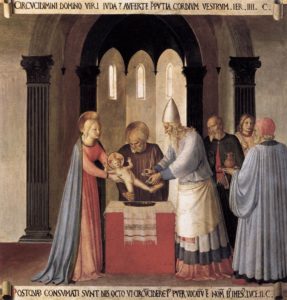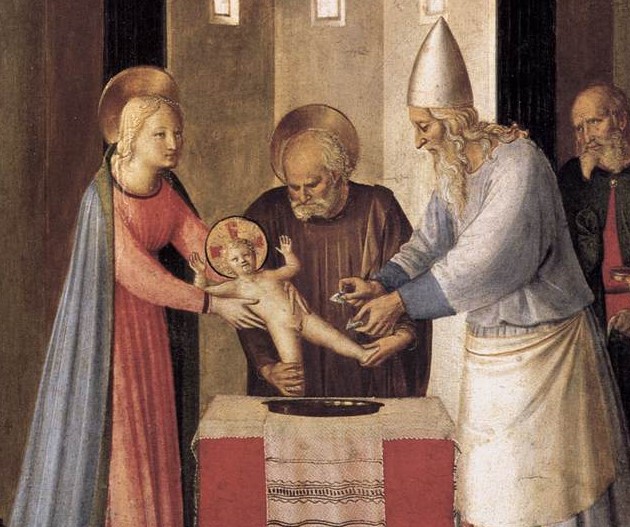 The feast for January 1st is designated as the Solemnity of Mary, Mother of God. Although that is its most ancient title, for many centuries it was the Circumcision of the Lord; it is still celebrated under that title on the calendar of the Extraordinary Form of the Roman Rite.
The feast for January 1st is designated as the Solemnity of Mary, Mother of God. Although that is its most ancient title, for many centuries it was the Circumcision of the Lord; it is still celebrated under that title on the calendar of the Extraordinary Form of the Roman Rite.
Yesterday we meditated on the Feast of Mary, Mother of God; today we will ponder the meaning of the Feast of the Lord’s Circumcision. In so doing we will follow the thoughts of St. Thomas Aquinas in his Summa Theologica. The words of St. Thomas are presented below in bold, black italics, while my commentary appears in plain red text.
As his focal question, St. Thomas asks,
Whether Christ should have been circumcised? (Summa Theologica III, Q 37, Art 1). He answer yes, and for the following reasons:
First, in order to prove the reality of His human nature, in contradiction to the Manicheans, who said that He had an imaginary body: and in contradiction to Apollinarius, who said that Christ’s body was consubstantial with His Godhead; and in contradiction to Valentine, who said that Christ brought His body from heaven.
The sacrament all touch and/or involve the body in some way. For example, we do not simply pray that a person be freed from original sin, we pour water upon the body. To be human is to be both body and spiritual soul.
There has long been a tendency toward a kind of dualism that seeks to make the body a container and locates the self purely in the soul. But Christ, in taking on human nature, took not only a likeness to us, but became fully human. As such, He truly had a body; His body was not a mirage or something uniquely crafted out of His divinity in order that He appear human. He was like us in all things except sin.
Circumcision emphasizes the importance of the body to us because it cuts the very sign of the Covenant into the body. All the sacraments of the New Covenant (to which circumcision points) touch the body in order to have effects on the soul.
Secondly, in order to show His approval of circumcision, which God had instituted of old.
Although the New Covenant no longer requires circumcision, the sacraments do not dishonor circumcision; they fulfill it.
Thirdly, in order to prove that He was descended from Abraham, who had received the commandment of circumcision as a sign of his faith in Him.
Fourthly, in order to take away from the Jews an excuse for not receiving Him, if He were uncircumcised.
Recall that St. Paul had Timothy circumcised for a similar reason (see Acts 16:3). Although Paul was clear that the Judaizers who insisted on circumcision as necessary for salvation were wrong, he made a pastoral and prudential decision to sidestep fruitless debate with them. St. Paul wrote elsewhere about his approach in matters such as this: To the Jews I became like a Jew, to win the Jews. To those under the Law I became like one under the Law (though I myself am not under the Law), to win those under the Law. (1 Cor 9:20).
Fifthly, “in order by His example to exhort us to be obedient” [Bede, Hom. x in Evang.]. Wherefore He was circumcised on the eighth day according to the prescription of the Law (Leviticus 12:3).
Until such time as the New Covenant was fully inaugurated, the Old Law still held. Hence obedience is demonstrated for us. If even the Son of God, who did not need the law’s effects (for He was sinless and law is for the weak), subjected Himself to the standing law and lawful authority, how much more should we be willing to do so.
In a similar matter, Jesus advised the apostles, The scribes and Pharisees sit in Moses’ seat. So practice and observe everything they tell you. But do not do what they do, for they do not practice what they preach (Matt 23:2-3).
To those who argue that circumcision ceased at the birth of Christ (since He Himself is the New Covenant), St Thomas answered, … we are freed by Christ’s Passion. Consequently, this figure was not completely fulfilled in Christ’s birth, but in His Passion, until which time the circumcision retained its virtue and status. Therefore, it behooved Christ to be circumcised as a son of Abraham before His Passion.
St. Thomas also cites the objections of some in his time who said that obedience in circumcision is not a fruitful example to us since we are under no obligation to be circumcised; then he adds this insight: Christ submitted to circumcision while it was yet of obligation. And thus His action in this should be imitated by us, in fulfilling those things which are of obligation in our own time. Because “there is a time and opportunity for every business” (Ecclesiastes 8:6).
Sixthly, “that He who had come in the likeness of sinful flesh might not reject the remedy whereby sinful flesh was wont to be healed.”
Though the Law could not of itself cure sin, it was a remedy in that it prepared us for Christ and help lead us to Him.
Seventhly, that by taking on Himself the burden of the Law, He might set others free therefrom, according to Galatians 4:4-5: “God sent His Son … made under the Law, that He might redeem them who were under the Law.”
Indeed, the Law had many burdens and punishments associated with it and did not contain the grace to accomplish it. Thus, the Lord took up these burdens and fulfilled them, accomplishing them in full so as to free us and give us the grace to live the new Law of Love. St. Paul says elsewhere, For God has done what the law, weakened by the flesh, could not do. By sending his own Son in the likeness of sinful flesh and for sin, he condemned sin in the flesh, in order that the righteous requirement of the law might be fulfilled in us, who walk not according to the flesh but according to the Spirit (Romans 8:3-4).
Here, then, are some teachings on the circumcision of the Lord. Even if the matter may seem arcane to us, to the Christians of the first generation it was a matter of great importance and something to be understood carefully. Through St. Thomas, the Lord gives us much to ponder.
Tomorrow we will consider another aspect of the eighth day of Christmas: the naming of Jesus.

